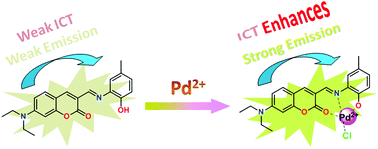Simple fabrication of a carbaldehyde based fluorescent “turn-on” probe for the selective and sole detection of Pd2+: application as test strips†
Abstract
A new fluorescent “turn-on” probe (DHMC) has been designed and synthesized to selectively detect Pd2+ among other cations at physiological pH. Upon incremental addition of Pd2+ into the probe solution, a “turn-on” emission enhancement was noticed with a ∼69 nm red shift at 562 nm in CH3CN/H2O (4/1, v/v) solution. The limit of detection and binding constant values have been determined and found to be on the order of 7.4 × 10−8 M and 1.7 × 105 M−1 respectively, which clearly suggests that the probe is very efficient in detecting Pd2+ at very minute levels and also the DHMC–Pd2+ complexation is stable enough too. A brilliant application of the probe has been explored which indicates that DHMC can detect Pd2+ in the solid state too. DFT and TDDFT calculations are carried out to interpret the electronic structure and sensing mechanism.



 Please wait while we load your content...
Please wait while we load your content...